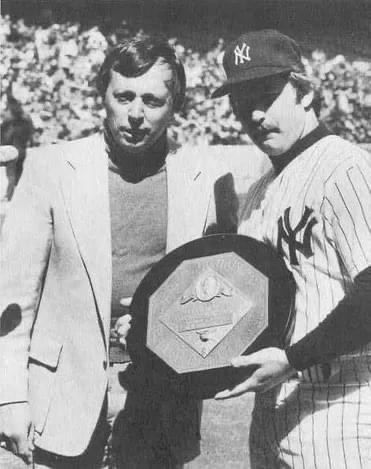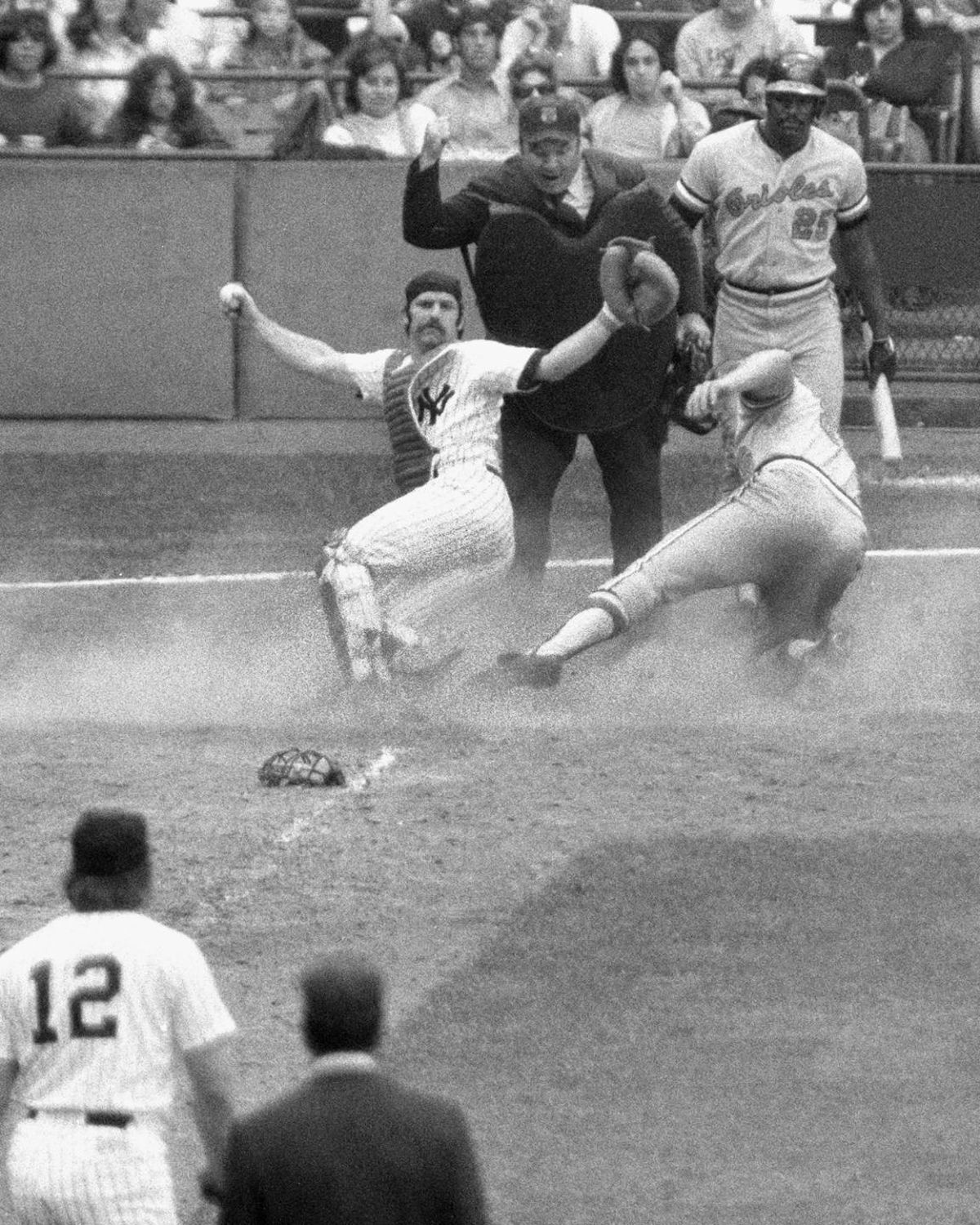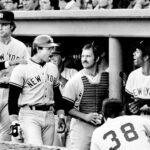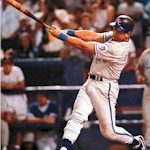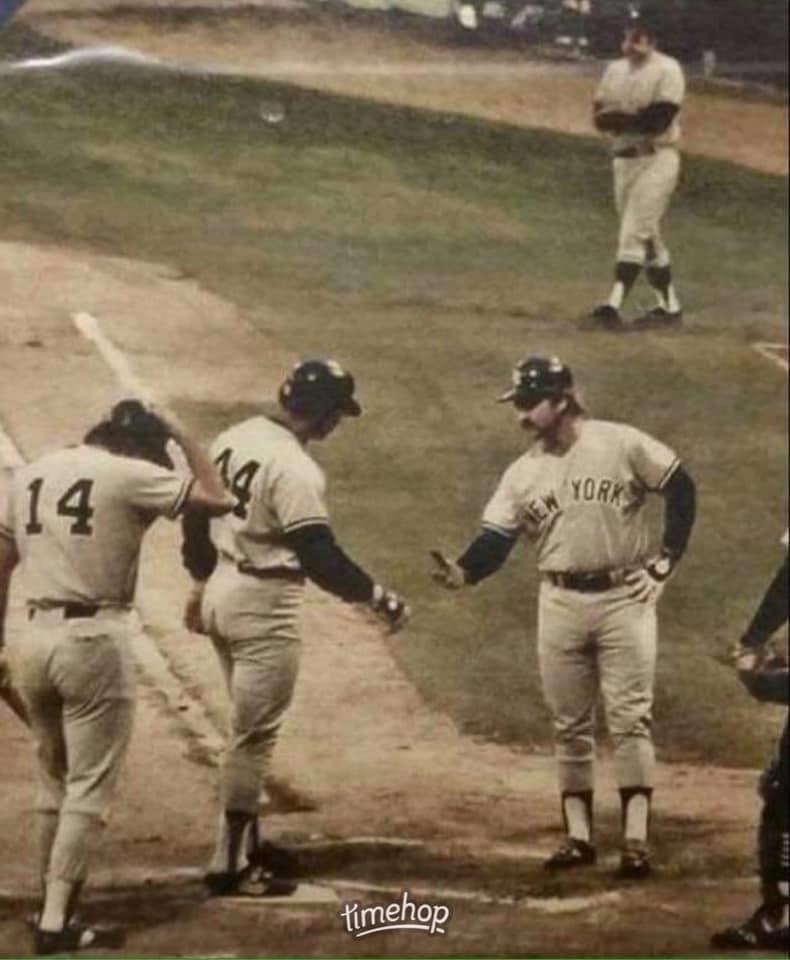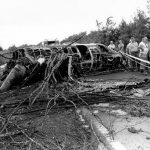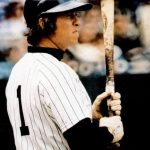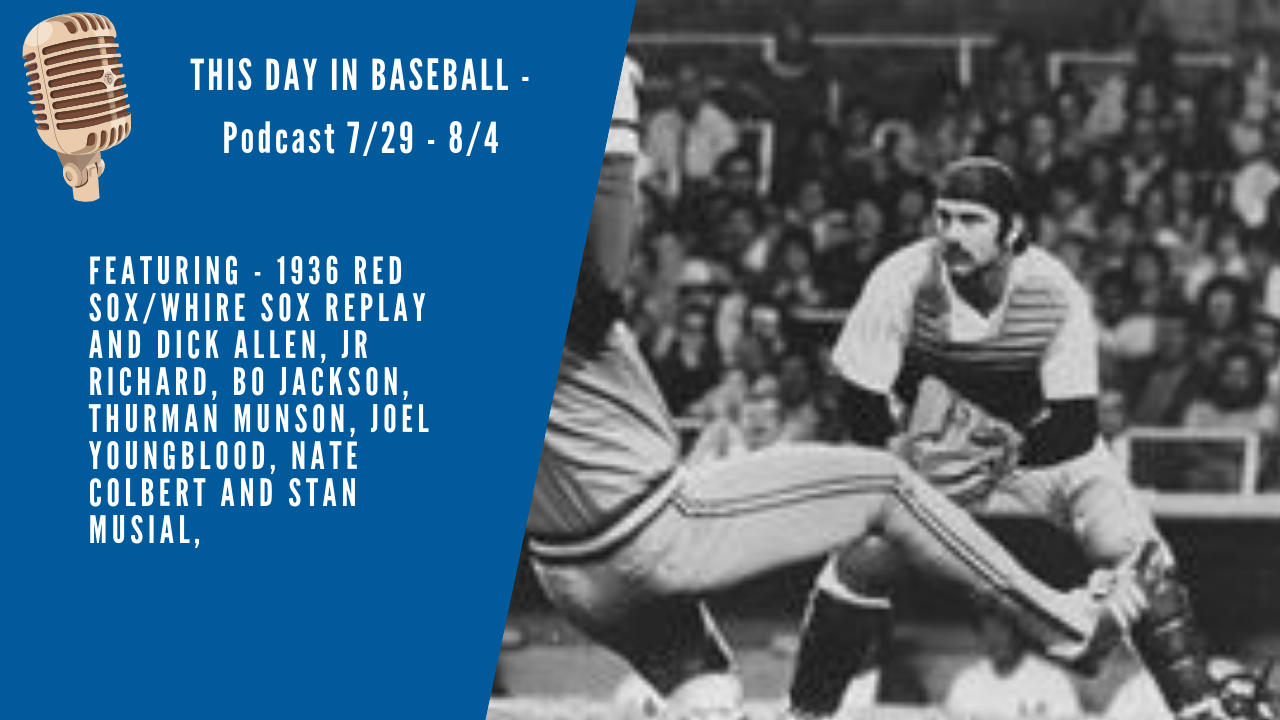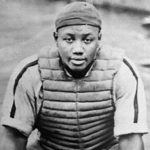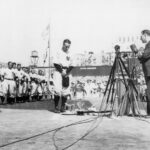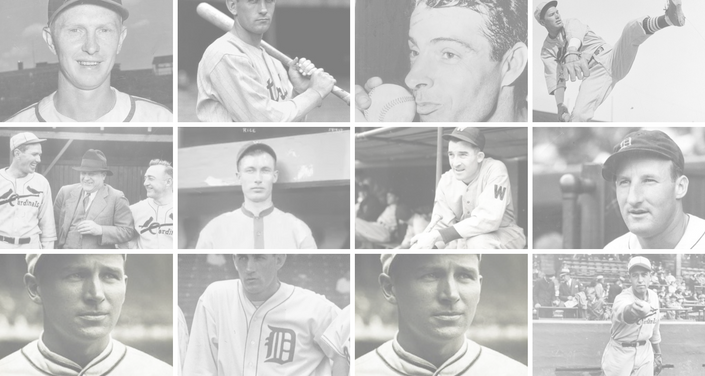Thurman Munson
Position: Catcher
Bats: Right • Throws: Right
5-11, 190lb (180cm, 86kg)
Born: June 7, 1947 in Akron, OH
Died: August 2, 1979 in Summit County, OH
Buried: Sunset Hills Cemetery, Canton, OH
Draft: Drafted by the New York Yankees in the 1st round (4th) of the 1968 MLB June Amateur Draft from Kent State University (Kent, OH).
High School: Lehman HS (Canton, OH)
School: Kent State University (Kent, OH)
Debut: August 8, 1969 (12,886th in major league history)
vs. OAK 3 AB, 2 H, 0 HR, 2 RBI, 0 SB
Last Game: August 1, 1979
vs. CHW 1 AB, 0 H, 0 HR, 0 RBI, 0 SB
Full Name: Thurman Lee Munson
Nicknames: Tugboat, Squatty Body or The Walrus
View Player Info from the B-R Bullpen
View Player Bio from the SABR BioProject
Nine Other Players Who Debuted in 1969
Darrell Evans
Bill Buckner
Carlton Fisk
Steve Garvey
Bill Russell
Toby Harrah
Vida Blue
Jerry Reuss
Thurman Munson
The Thurman MunsonTeammate Team
C: Rick Dempsey
1B: Chris Chambliss
2B: Willie Randolph
3B: Graig Nettles
SS: Gene Michael
LF: Roy White
CF: Bobby Murcer
RF: Bobby Bonds
DH: Reggie Jackson
SP: Mel Stottlemyre
SP: Fritz Peterson
SP: Catfish Hunter
SP: Ed Figueroa
SP: Ron Guidry
RP: Sparky Lyle
RP: Goose Gossage
M: Billy Martin
Notable Events and Chronology for Thurman Munson Career
Thurman Munson Biography
A rich tradition of outstanding catchers already existed on the New York Yankees by 1970. Either Bill Dickey, Yogi Berra, or Elston Howard manned the position for the Yankees in virtually all of the previous 40 seasons. Following in the footsteps of those three exceptional receivers was Thurman Munson, who arrived in New York as a brash and cocky 22-year-old in 1970, brimming with so much self-confidence that he annoyed not only many opposing players, but even initially surprised some of his own teammates with his temerity. Within a few years, though, Munson established himself as one of the American League’s most admired and respected players, and as one of the most beloved figures in New York sports history.
Early Career:
Thurman Lee Munson was born in Akron, Ohio on June 7, 1947. After starring in baseball, football, and basketball in high school, he attended Kent State University on a baseball scholarship. Upon his graduation, the 21-year-old Munson was selected by the Yankees with the fourth overall pick of the 1968 amateur draft. Ascending rapidly through the New York farm system, Munson appeared in less than 100 minor league games before earning a permanent call-up to the majors in August of 1969. In 86 at-bats with New York over the season’s final two months, Munson batted .256 and hit his first major league home run. His performance so impressed the members of the Yankee front office that they traded away incumbent receiver Frank Fernandez during the off-season, all but handing the starting job to Munson.
Still, the trust the Yankee front office placed in Munson failed to exceed the amount of confidence the young man had in his own abilities. Former teammate and close friend Bobby Murcer, who was in his first full major league season himself when Munson first joined the team in 1969, said of the receiver, “He felt like he belonged the first time he stepped on the field here at Yankee Stadium…The late ’60s and early ’70s, rookies were supposed to be seen and not heard. Thurman was a different kind of rookie – he was seen and heard.”
Fellow Kent State alumnus Gene Michael, who roomed with Munson his first few years in the league, suggested, “Thurman got away with more things as a rookie than most players would. For some reason, they accepted Thurman quickly…his brashness and that. But he really wasn’t that way. He was very concerned and compassionate in a lot of ways.”
The confidence Munson had in himself helped him make it through the difficult early days of his 1970 rookie season. Off to a terrible start, he continued to believe in himself, as did manager Ralph Houk, who stuck with the struggling rookie despite his early slump. Munson rewarded Houk by finishing the season with a .302 batting average and winning American League Rookie of the Year honors. Although his average dropped to .251 the following season, Munson made the All-Star Team for the first of seven times, beginning a longtime rivalry shortly thereafter with Boston’s Carlton Fisk, who captured A.L. Rookie of the Year honors the following year.
More than just a solid hitter, Munson displayed remarkable quickness and agility behind the plate his first few years in the league. While he did not possess the powerful throwing arm of Johnny Bench, Munson had perhaps the quickest release in baseball, and he displayed an extraordinary amount of agility coming out from behind the plate on slowly-hit balls.
Mel Stottlemyre, who pitched to Munson in the latter’s early years on the team, stated, “He was so sure of himself, and so sure of what he could do behind the plate. He was known for his quickness behind the plate. He was as quick as anybody I’ve ever seen coming out from behind that crouch on bunted balls and on his throws to second base.”
Although Munson’s throwing efficiency suffered in later years due to the constant pounding he endured behind the plate, he excelled as a defender early in his career. In addition to his tremendous quickness, Munson had an accurate throwing arm, committing only one error throughout the entire 1971 campaign.
Munson neither hit for much power nor drove in a lot of runs during the early stages of his career. He failed to hit more than 10 home runs or drive in more than 53 runs in any of his first three seasons. Primarily an opposite field, line-drive hitter at that juncture, Munson generally chose not to challenge old Yankee Stadium’s “Death Valley” in left-center and centerfield. As a result, he usually batted second in the Yankee lineup. However, Munson began to find his power-stroke in 1973, when he simultaneously improved his techniques at turning on inside pitches and relaxing when he stepped into the batter’s box with men on base. In his first truly productive offensive season, Munson hit 20 home runs, knocked in 74 runs, and batted .301.
Development into Team Leader:
In addition to increasing his offensive productivity, Munson became more of a team leader. Extremely competitive, and possessing a burning desire to win, he challenged his teammates to work as hard as they possibly could, always seeking to bring out the best in them.
Outfielder Elliott Maddox, who had his best major league season in his first year with the team in 1974, spoke of the kind of leader Munson was and of the influence he had on him: “If Thurman was on your case and telling you, ‘You have to apply yourself more, you have to do this, or you have to do that because you know you’re capable of it,’ it meant he liked you. So, he loved me because he never gave me a moment’s peace…So, you would want to do it, just to get him off your back.”
Munson reached his peak during the mid-1970s, batting over .300 and driving in more than 100 runs in three consecutive seasons (1975-1977). He hit a career-high .318 in 1975, then followed that up by winning the American League’s Most Valuable Player Award in 1976 by hitting 17 home runs, driving in 105 runs, batting .302, and leading the Yankees to their first pennant in 12 seasons. The following year, Munson hit 18 homers, knocked in 100 runs, and batted .308. However, due to the number of injuries he sustained over the years from catching more than 130 games a season for practically his entire career, Munson’s productivity began to decline in 1978. Although he batted .297, he hit only six home runs and knocked in just 71 runs. Yet, he helped lead his team to the world championship for the second straight season with his clutch hitting, superb handling of the pitching staff, and tremendous leadership qualities. In fact, many of his teammates considered Munson to be the most important and indispensable player on the team – in essence, the glue that held the rest of the team together.
Ron Guidry, who first became a regular member of the starting rotation in 1977, said,”Having him there, everybody kind of revolved around him, because you could take me out of a game and they could still play and win. You could take somebody else out and they could probably still win. But, if you took Thurman out, our chances of winning were half as good.”
Guidry also spoke of the confidence Munson instilled in his pitchers: “Pitching was made easier because I got to throw to a guy like Thurman. He made pitchers that were average ones good. He made them win a lot of games because of his ability to take all the pressure and call the game. We all felt like: ‘That’s the best pitch to throw. I’m not gonna’ second-guess it and say it’s not.’ I could have thrown a guy 20 sliders and made him look foolish, but, if he called for a fastball, that’s what I threw.”
Willie Randolph, who joined the Yankees in Munson’s MVP season of 1976, discussed the catcher’s all-around ability: “When you think of Thurman Munson, you think about the total package. This man could even run. Most catchers back then would just go base to base. Thurman would take you first to third in a minute. If you needed an RBI, he could hit that patented line drive to right to drive in runs. If you needed a home run, he could turn on you and take you deep. The total package. I don’t think, even when you talk about the great catchers of the game – and he was obviously up there – none of those guys really did everything well like Thurman did. He did everything that was necessary to win.”
While Munson’s offensive production began to decline his final two seasons, he nevertheless accomplished enough his first several years in the league to be grouped with the great Yankee catchers who preceded him. In fact, Munson was quite proud of his linkage to Bill Dickey, Yogi Berra, and Elston Howard. Like Berra and Howard, he earned A.L. MVP honors. He also finished in the top ten in the voting two other times. In addition to being selected to the American League All-Star team a total of seven times, Munson was named to The Sporting News All-Star team four times and was awarded three Gold Gloves.
Captain Clutch:
The first Yankee captain since Lou Gehrig, Munson also gradually developed into one of the finest clutch performers of his time. Longtime Kansas City Royals batting coach Charlie Lau commented, “Of all the Yankee hitters, Thurman Munson was the one that scared me the most when he came up. He had that swing and that heart, he was just totally clutch.”
Lau’s statement was well-founded. In 14 ALCS games, Munson hit two home runs, knocked in 10 runs, and batted .339. In 16 World Series contests, he hit one homer, drove in 12 runs, and batted .373. Even though the Yankees were swept by Cincinnati in the 1976 World Series, Munson batted .529 and had six hits in his final six at-bats.
Demonstrating the admiration and respect many of Munson’s opponents had for him, Reds’ catcher Johnny Bench stated, “I was always totally amazed at Thurman. I thought he was one of the greatest competitors I’ve ever known.”
One particular moment that stood out as an example of Munson’s competitive spirit and clutch play was the third game of the 1978 ALCS against the Royals. As the result of a badly damaged shoulder and a bruised and battered body, Munson failed to hit a home run in more than two months. Yet, with the Series tied at one game apiece and the Yankees down by a run late in the game, Munson hit a ball about 30 feet over the 430-foot sign in deepest left-center field at Yankee Stadium to win the game. Perhaps it was that kind of intestinal fortitude that prompted Reggie Jackson to write of Munson in his autobiography, “Had he lived, I bet we would have won two more World Series in New York, both in 1980 and in 1981.”
Death and Legacy:
Munson unfortunately was not a member of the Yankees in either of those years since his life tragically ended on August 2, 1979. While practicing takeoffs and landings in his private plane in Akron, Ohio, Munson perished when the plane hit a tree. Munson’s tragic death left his teammates and Yankee fans alike stunned and deeply saddened. Perhaps Ron Guidry expressed everyone’s feelings best when he said, “I had the feeling that it would never be the same. I said to myself: ‘I’m gonna’ win games, but it will never be the same again, because you can’t replace him.’ There was no way to replace that man.”
More than 30 years have now passed since Thurman Munson played his last game for the New York Yankees. Nevertheless, he continues to remain a prominent figure in the hearts and minds of Yankee fans and players alike. Munson’s locker remained empty in the old Yankee Stadium clubhouse – unused by anyone since his death. It has since been moved to the new Yankee Stadium to serve as a reminder of the team’s fallen captain.
Joe Torre, who managed the Yankees to four world championships and 12 consecutive playoff appearances during his 12 seasons in the Bronx, once suggested, “The way he (Munson) played the game exemplifies what we have been about….I just sense that Thurman is in everybody’s ear during the course of the season. There’s no question his presence in the clubhouse is felt because of his locker.”
@ET-DC@eyJkeW5hbWljIjp0cnVlLCJjb250ZW50IjoicG9zdF90YWdzIiwic2V0dGluZ3MiOnsiYmVmb3JlIjoiTGVhcm4gTW9yZSBhYm91dCB0aGUgdGVhbXMsIHBsYXllcnMsIGJhbGwgcGFya3MgYW5kIGV2ZW50cyB0aGF0IGhhcHBlbmVkIG9uIHRoaXMgZGF0ZSBpbiBoaXN0b3J5IC0gLSAtIC0gLSAtIC0gIiwiYWZ0ZXIiOiIiLCJsaW5rX3RvX3Rlcm1fcGFnZSI6Im9uIiwic2VwYXJhdG9yIjoiIHwgIiwiY2F0ZWdvcnlfdHlwZSI6InBvc3RfdGFnIn19@
Card Collections ENDING SOON ON EBAY
MOST WANTED ROOKIE CARDS
VINTAGE SPORTS TICKETS
Baseball Hall of Famers
Factoids, Quotes, Milestones and Odd Facts
Played For
New York Yankees (1969-1979)
Linked: Carlton Fisk was the primary catcher who Munson was compared to during his career. In 1973 they fought in Fenway Park after Munson plowed into Fisk at the plate… Bobby Murcer became Munson’s best friend on the Yankees… Munson helped ensure that George Brett wasn’t unfairly pummelled in a brawl between the Yanks and Royals in 1976… In the 1976 World Series, many compared Munson to Johnny Bench, the Reds’ Hall of Fame catcher… Munson and Reggie Jackson were at odds in 1977 over an interview Jackson did in which he denigrated Munson, and claimed that Reggie was “the straw that stirs the drink” for the Yankees.
Best Season, 1976
Munson hit for a higher average and had better power numbers in other seasons, but in 1976 he guided the Yankees to their first pennant in 12 years. He hit .302 with 186 hits, 27 doubles, 17 homers and 105 RBI. In the post-season he hit a red-hot .475 with 19 hits in nine games, and five RBI.
Awards and Honors
1970 AL Rookie of the Year
1973 AL Gold Glove
1974 AL Gold Glove
1975 AL Gold Glove
1976 AL MVP
Post-Season Appearances
1976 American League Championship Series
1976 World Series
1977 American League Championship Series
1977 World Series
1978 American League Championship Series
1978 World Series
Post-Season Notes
In the 1976 World Series, Munson set a record with seven straight hits, all but one of which were singles. In 1990, Billy Hatcher tied that mark.
Notes
In 1978, when the Yankees were chasing the first-place Red Sox in early September, Munson went 8-for-16 in the series that became known as the “Boston Massacre” The four games were played from September 7-10, in Fenway, and the Yanks won by scores of 15-3, 13-2, 7-0 and 7-4. The sweep pulled the Bombers into a tie for the AL East lead.
Transactions
June 7, 1968: Drafted by the New York Yankees in the 1st round (4th pick) of the 1968 amateur draft.
Murcer’s Tribute
On August 3, 1979, a day after Munson died in a plane crash in Canton, Ohio, a memorial tribute was held at Yankee Stadium. More than 51,000 fans attended the tribute, which included Munson’s teammates and representatives of major league baseball. Three days later at the funeral, Yankee outfielder Bobby Murcer delivered the eulogy for his fallen friend. The next day, in his first start since the tragedy, Murcer rallied New York from a 4-0 deficit. In the seventh inning he belted a three-run homer off Dennis Martinez to pull the Yanks to within one run. In the bottom of the ninth, with runners on second and third, Murcer lined a single to left field, scoring both runners for a dramatic and emotional 5-4 win.
Pine Tar Game #1
On July 19, 1975, in a game that the Yanks lost 2-1 to the Twins, Munson had an RBI-single nullified in the first inning when it was ruled that the pine tar on his bat exceeded the 18-inch limit. Eight years later, the Yankees would get a measure of revenge when they nabbed George Brett for the same infraction.
All-Star Selections
1971 AL
1973 AL
1974 AL
1975 AL
1976 AL
1977 AL
1978 AL
Replaced
Jake Gibbs, who was the transitional catcher between Elston Howard and Munson. Gibbs was stuck behind Howard from 1962-1966, before settling in as the starter for 1967 and 1968. When Munson emerged in 1969, Gibbs was again shelved, serving as #2 backstop through 1971.
Replaced By
Jerry Narron, and ultimately Rick Cerone.
Best Strength as a Player
Leadership and clutch hitting. In a career in which he had a .292 average, Munson hit .307 with men on base, and .302 with runners in scoring position.
Largest Weakness as a Player
Speed
Other Resources & Links
More Munson Pages
If you would like to add a link or add information for player pages, please contact us here.


